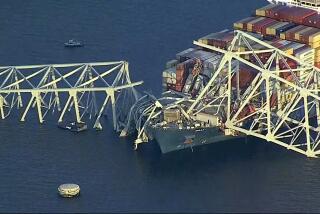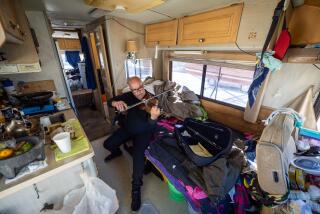They Seized the Moment and Came to America : Immigration: Mariel boat-lift refugees live down their bad image and enter the U.S. mainstream. But 6,000 remain in custody.
- Share via
MIAMI — Ten years ago this month the waters of the Florida Straits churned in prop chop. Thunderstorms occasionally raked the seas with lightning and water spouts, but nothing shut down the 100-mile shuttle between Key West and the Cuban port of Mariel.
People who had never been to sea in their lives hung over the sides of shrimpers and yachts with names they didn’t know, sick from motion and anxiety. But still they kept coming.
“I was very afraid, I remember that,” said Nara Roza, just 11 when she, her parents, a brother and 13 others boarded a small open boat which would carry them from one Cuban society to a vastly different one in Miami. “And then the motor broke down and we drifted in the Gulf Stream for hours before the Coast Guard found us. But I wanted to go; I never had second thoughts about that. We were all ready to leave.”
Roza, now 21 and a reporter for Miami Spanish-language television station WSCV, is one of the more visible of the 125,266 Cubans who poured into South Florida during five months of euphoria, anguish and chaos beginning in April, 1980.
She is happy in her work, grateful to be an American and proud of her success and her provenance. At times, she has even identified herself as a marielita, a term that more often than not has been used in derision.
Indeed, 10 years worth of success stories have slowly altered the popular perception of Mariel as a debacle that left Florida’s streets awash in criminals and the country’s immigration policy in disarray.
The sudden swelling of Miami’s Cuban population by one-fifth ignited a widespread revitalization of Spanish-language culture here that many welcomed after 20 years of American dilution. Now, people such as Braulio A. Saenz, a professor at Miami-Dade Community College, each term delights in telling his students that he came to the United States in the boat lift. “At first, they were shocked,” he said. “But now people know that all kinds came.”
Still, a decade after the most tumultuous wave of immigration ever to sweep over U.S. shores, Americans--especially Cuban-Americans--are still struggling to come to grips with the exodus. Fidel Castro crowed that he was ridding his island nation of its escoria, its scum, through Mariel, and the perception that the reviled Cuban leader had bested the U.S. government shocked exiles here.
“There was a lot of turmoil here in Miami,” Max Castro, a sociologist who left Cuba 20 years before Mariel, said. “There was a sense that a real calamity had descended on the community. There was a lot of misunderstanding.”
In retrospect, the misunderstanding seems inevitable. Although the vast majority of the refugees who arrived from Mariel were quickly assimilated into American life--80% in South Florida--a few thousand criminals, mental patients and social misfits salted in among the newcomers touched off a local crime wave and a national image problem that persists to this day.
In 1984, a deranged man with the street name of “El Loco,” The Crazy One, was charged with gunning down a Miami Beach police officer. In 1987, the threat of deportation touched off a 13-day rampage by 2,000 Cubans imprisoned in Louisiana and Atlanta that became a nightly staple of television network news. In March, a 36-year-old Bronx resident named Julio Gonzalez was charged with arson and murder in the fire that killed 87 people in the Happy Land social club. In each highly publicized incident, the bad guys were marielitos.
How a word that began as a term of endearment--in Spanish the diminutive ito is usually used in affection--became an epithet with the power to sting cannot be completely explained by surging crime statistics alone.
“Really, it’s the fault of the Cuban community that was here,” said Siro del Castillo, a longtime Miami resident who founded a support group for Mariel refugees. “We discriminated against these people because we thought they were jeopardizing our good name.”
The crime rate did skyrocket after Mariel. Homicides in Miami were up 66% in 1980, according to police figures. But, at the same time, Miami was under siege by other forces as well. As boatloads of Cubans continued to arrive, 25,000 Haitians also were sailing into South Florida. Ten years ago this month, Miami’s black community erupted over the acquittal of several police officers charged with the beating death of a black insurance man. Eighteen people died in three days of rioting.
“There were so many problems,” Del Castillo said. And, somehow, the word marielito assumed a power of its own.
“Sometimes it still hurts me when I hear it,” Roza said. “Just because you came over on the boat lift doesn’t mean that you are an undesirable person, that you’re trash. I had to face a lot of discrimination here at first in school. People would say marielita like it was the plague. But I have learned to live with that. And I think Mariel people have proven themselves.”
In fact, recent surveys indicate that most Cubans who arrived in the Mariel exodus are not much different from earlier exiles. The majority of both groups identify with the Republican Party, pay their taxes, value home ownership and American citizenship and practice Catholicism.
About 4,000 Mariel refugees are behind bars, doing time in state or federal prisons for crimes committed here. An additional 2,600 Mariel arrivals are held in custody by the U.S. Immigration and Naturalization Service. And 375 more have been deported to Cuba. That represents about 5% of those who came from Mariel.
“They have done extremely well, in employment, home ownership, in adapting to the community and becoming productive members of society,” said Juan Clark, a Miami sociologist who has studied the Mariel group. “We are now able to see that the majority is (made up of) positive, contributing, hard-working people. But that hard-core element created a bad image.”
Among the established middle-class Cuban community in Miami, it was not just the criminals who caused concern. The Mariel refugees were a more representative cross-section of the Cuban people than were the well-off professionals who had fled the revolution in the early 1960s.
In general, the Mariel refugees represented another generation: They were younger, less educated, darker-skinned than their predecessors. Many brought with them an interest in Afro-Cuban religions, such as Santeria. And, in the Miami communidad, those differences contributed to concerns as to what 20 years of living under communism had wrought, especially regarding the willingness of the new arrivals to work.
“Many younger people came with attitudes conducive to survival there, but not here,” Clark said. “They had to learn the work ethic, and that was another handicap.”
The suddenness with which the Mariel boat lift happened was also a factor in who came. Some of the refugees had been preparing to leave Cuba for years. But many more, urged on by impulse or by relatives in the United States, merely seized the moment.
“I didn’t come for free clothes or food,” said Gervasio Esturo, a 46-year-old illustrator. “I just saw the chance to be in a free country, to build a life.”
The series of events that led to the Mariel boat lift began in early April, 1980, when six Cubans drove a bus through the gates of the Peruvian Embassy in Havana. When Peru granted them asylum, the Cuban government removed its guards from the embassy’s gates and announced that the embassy was open to all. In four days, 10,800 people packed the grounds.
Embarrassed by the numbers who wanted out of Cuba, Castro on April 19 announced that he would open the port of Mariel, a small town about 30 miles west of Havana, and invited Cubans in the United States to come and get their relatives. And Miami went wild.
Cubans separated from their families for years rushed to Key West with boats and money, desperate to bring out relatives. The first refugees from Cuba, 48 people on two fishing boats, arrived in Key West on April 21. Three days later, there were almost 400 American boats lying at anchor in Mariel harbor.
By early May, the Orange Bowl was full of refugees, a tent city housing thousands more was set up under Interstate 95 in Miami’s Little Havana, and both the Cuban community and the Jimmy Carter Administration began to realize that not all of the people coming out of Mariel were relatives and friends of people long settled in Miami. Criminals, mental patients, homosexuals and others labeled dangerous to Cuban society also were put on boats.
Although several thousand U.S. Cubans had visited the island in 1979 during a brief relaxation of hostilities between the two nations, the Mariel boat lift brought about the first face-to-face meeting of two distinct generations of Cubans. And, when the initial euphoria subsided, differences emerged.
Many Miami Cubans who had spent 20 years romanticizing pre-Castro Cuba--and condemning all that followed the revolution--were surprised when Mariel arrivals praised socialized medicine and the Cuban educational system, for example. “I think we helped liberalize the community here,” Saenz said. “Here, they were totally isolated” from what was going on in Cuba, he added.
Maria Elena Cros, a librarian when she left Cuba in 1980 and now a writer for Cosmopolitan magazine’s Spanish edition, said: “They often expected everything about Cuba to be negative. We helped each other with reality.”
Cros’ sister, Mercedes Sandoval, is an anthropologist at Miami-Dade Community College. She has lived in Miami for 35 years. In researching her book, “Mariel and Cuban National Identity,” Sandoval found that, although differences do exist between the Mariel refugees and those Cubans who came to Miami in earlier waves, anti-Cuban sentiments among non-Cubans in South Florida and the rest of the United States have served to bring the two generations together.
Her sister agrees. “We are more understanding of each other now, and even more united,” said Cros, 61. “We have helped each other.”
But stereotypes die hard, both here and in Cuba. One study published by Havana sociologists reported that 45% of all those who left the island from Mariel had a criminal past, most for such offenses as robbery, theft and fraud. Others were branded “dangerous to the state” for behaviors that included drunkenness, prostitution, vagrancy and general anti-social conduct.
Cuban-American sociologists know of that study, published in 1986 in Cuadernos de Nuestra America, and they know the Cuban sociologists who wrote it. But no study of Mariel refugees here has ever come close to confirming it.
“There were a lot of writers and artists in the Mariel group, intellectuals involved with social protest,” said Armando Gonzalez, an engineer who heads a group called Facts About Cuban Exiles, founded to combat the negative image of Mariel. “Those were the people Castro wanted to get rid of.
“The Mariel people have proven they are no different from other Cuban exiles. They have no qualms about saying: ‘Yes, I came by Mariel.’ But the word marielito is disappearing from daily use, and maybe it’s time we closed the book on it. It has a pejorative sense, and, when things like the New York fire happen, and it gets used in the press, it hurts everyone.
“The people who came in 1980 just want to be known as Cuban-Americans, like everyone else.”
More to Read
Sign up for Essential California
The most important California stories and recommendations in your inbox every morning.
You may occasionally receive promotional content from the Los Angeles Times.










